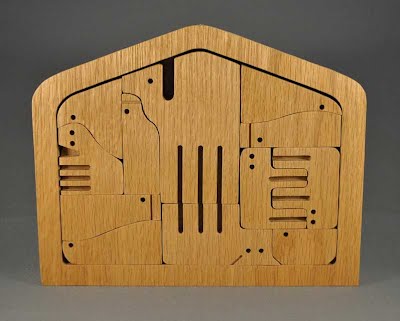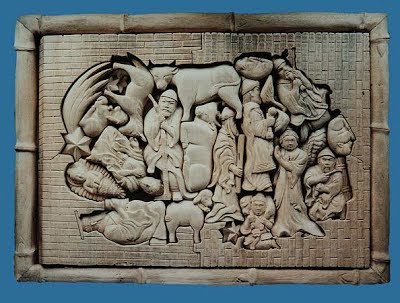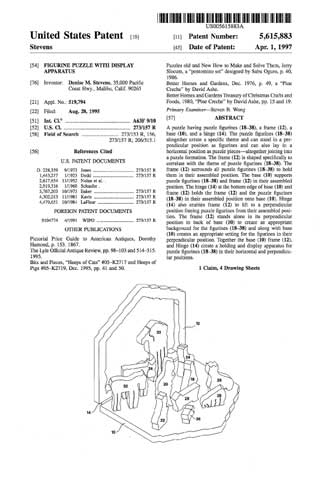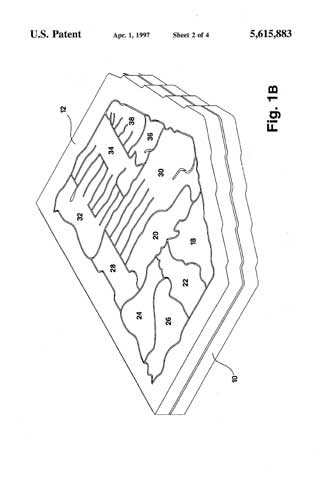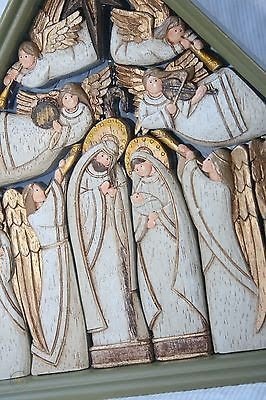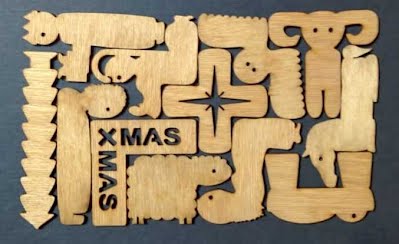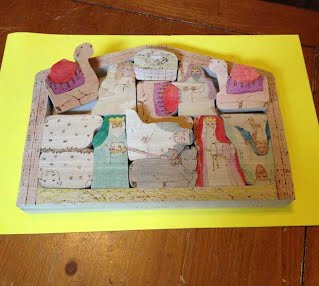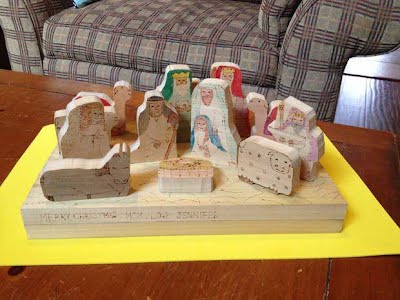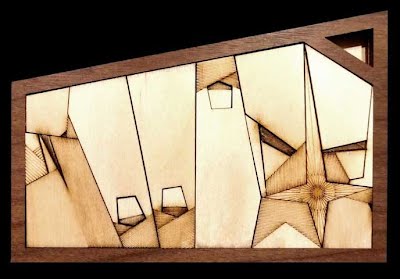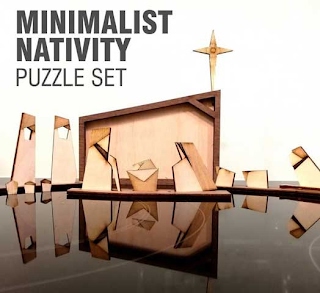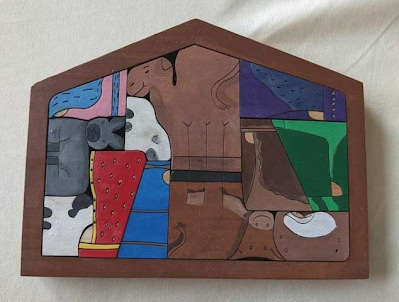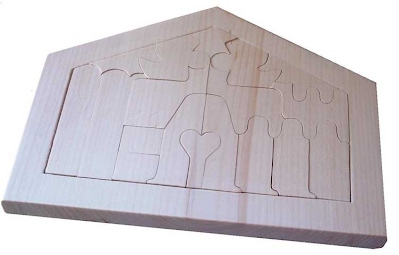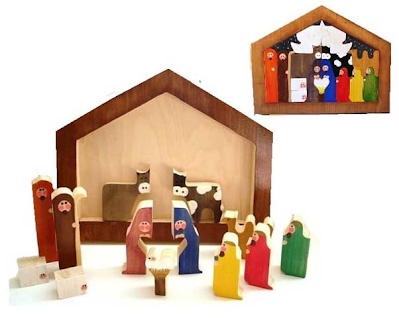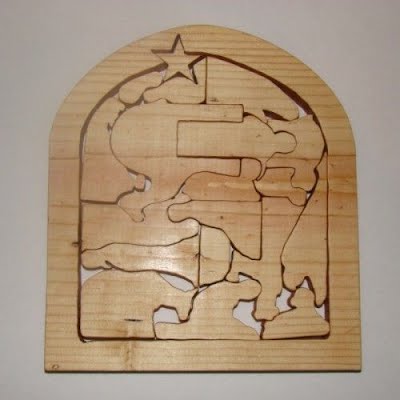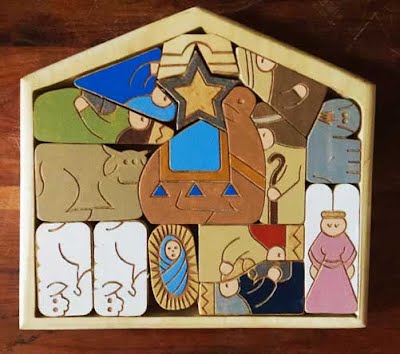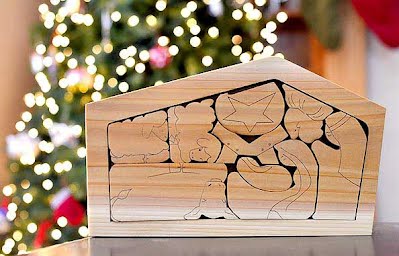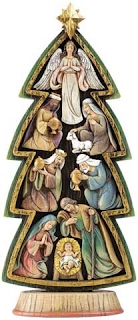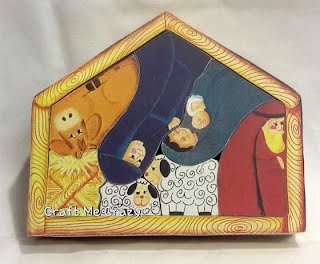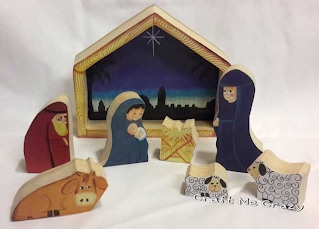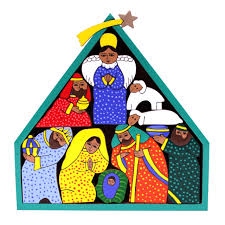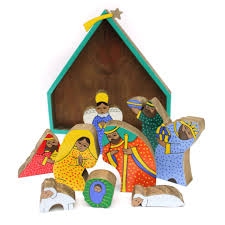Contents 1. 1950s?, ‘MyVintagePleasures’ (no real name given), US 2. 1976, David Ashe (likely) 3. 1992, 1993 and 2003, Götz-Peter Reichelt 4. 1997, Denise M. Stevens 5. 2009, Hallmark/Roman Inc 8. 2014, ‘Beetlesmart’ (Jennifer?) 9. Date Not Known. ‘Designs for the Heart’ 10. 2019, Melissa Griffiths, of ‘BlessthisMessPlease’ 13. Date Not Known. Amy, of ‘Peekaboo’ 14. Date Not Known. LIfeWithFingerPrints 15. 2018? Date Not Known with certainty. ‘Ucn’ 16. Date Unknown, of Uncertain Origin. ‘Amish’? 17. C. 2019, Jennifer Rose, of RoseWoodToys, Washington, United States 18. Date Unknown. Amber Hire, of CraftMeCrazy, Idaho, United States 19. Date Unknown. ‘Concern America’ Introduction Nativity Scenes, along with Noah's Ark, can be described as one of the two more popular cluster puzzle themes. 18 distinct works are identified. However, I have to say, most, if not the greater majority, are lacking in any real quality. Indeed, there is only one artist of any real note, Götz-Peter Reichelt, who can truly be said to have applied himself conscientiously to the concept. All too often, the works here are largely poorly thought through, with at times a slipshod approach. Further, not all are true to the ‘no gaps’ premise, with on occasion considerable gaps. Likely, the various designs were unaware of the cluster puzzle premise. Unlike other puzzles, I am bedevilled here by a lack of certainty as to the designer and date. Typically instances are ‘borrowed’ from scroll saw magazines or reposted from other sources, of which unravelling the chain is a tiresome process, even for the ‘super enthusiast’ like myself. However, even my enthusiasm has its limits, and of which I generally do not pursue beyond an initial look; the time is judged too excessive for any likely benefit gained. Dates are generally not given. Many, typically lesser instances, can be found on Pinterest and Etsy. I may even on occasion inadvertently falsely credited the designer. However, researching these from general online resources is more problematic. I have done my best, or at least of the time I want to devote to this. Corrections are welcome.
Typically the Nativity Scene includes relatively few figures. Although the story is well known in the broad sense, there are various nuances that I was unaware of, and so perhaps this applies to other people as well. For of the sake of exactness I thus give a broad overview, from Wikipedia: Nativity scenes exhibit figures representing the infant Jesus, his mother, Mary, and her husband, Joseph. Other characters from the nativity story, such as shepherds, sheep, and angels may be displayed near the manger in a barn (or cave) intended to accommodate farm animals, as described in the Gospel of Luke. A donkey and an ox are typically depicted in the scene, and the Magi and their camels, described in the Gospel of Matthew, are also included. Several cultures add other characters and objects that may or may not be Biblical. As can be seen, beyond the core characters there is little that is fixed. For instance, one could include just the infant Jesus, Mary, Joseph, whilst another could include secondary characters, with shepherds, sheep, and angels. The shape of the barn is not stated in the text. I have seen both symmetrical and non-symmetrical shapes. Sometimes the Star of Bethlehem is included, and or a comet, and sometimes not. And as different religious texts give different versions, all of which gives plenty of leeway.
The 19 Designers Below I show a listing as according to the chronology where known. Many puzzles are undated, and where this is so I thus loosely gather these at the end of the listing. 1. 1950s?, by ‘MyVintagePleasures’ (no real name given), US I’ll begin by saying that the early date here (which is an estimate by the puzzle’s owner, without any documentation) is with considerable reservation, as detailed below. However, for now at least I will accept this at face value as the first Nativity Scene cluster puzzle. Another interesting instance is described as a ‘Christmas Nativity Puzzle Part 1 Clay Aymara Indians Lake Titicaca’. I found it offered for sale, by ‘MyVintagePleasures’, at a premium price, $475, on ‘ArtFire’ (an online artisan shop like Etsy). It is described as follows (with minor editing of peripheral detail): This unbelievable nativity in clay is constructed as a puzzle. The parts will stand independently or place in box for scene that fits just as a puzzle. You can see the Bolivian Chullo Hats, the Bowler hats worn by the women, and the baby Jesus small cap. I love the animals that show the area of the country - the llama, chicken, lambs, bull, goats, water jugs, all the vegetation. The clothing, faces and colors depict the Bolivian culture of the Aymara Indians. This piece measures 11 x 11 1/2" inside the box - the puzzle. The outside of the box measures 12 x 12 1/2". The Christmas puzzle weight is 6 lbs. Vintage Origin Details: Manufacturer/Designer - Unknown Year (estimate) - 1950s Item Condition - Excellent Country of Origin - Bolivia Primary Material - Clay And Nativity Puzzle Bolivia clay unique conversation piece handmade Details Please see other part of puzzle box on site. This was so detailed and large I took two sets of pictures This phenomenal Nativity puzzle has been the centerpiece of our Christmas display for years. There are 24 parts. Each one fits perfectly together - no space to spare. Every year I bring to the family event and everyone enjoys. Look at the detail of the animals, people, little baby Jesus (he's male- if you look closely) all the faces in the puzzle are different; the mountains, animals with characteristics the Star in the East. I don't travel to foreign countries, but have never seen another like this! I don't let people touch too much - paint is delicate. If you want more pictures, let me know. Details of the puzzle are, not unexpectedly, are in broad commercial terms of interest, rather than writing for a puzzle enthusiast. However, it is quite detailed and contains all the core details. Naturally, I contacted the seller for more detail, but he didn't respond. Of note is the adaptation of typical Bolivian aspects to the Nativity, as seen in other country instances, with their own cultural adaptations. Of the puzzles overall, this is one of the better ones. Also, see the Götz-Peter Reichelt entry below for a similar cultural adaptation. Open questions abound. As can be seen, the date is an estimate, but how this was derived is unclear. A pure, simple ‘creative’ guess? I say creative, to give an old age, and so desirable to the collector? If it was indeed the 1950s, this would be very interesting historically, being the first such instance of the theme. The item's condition is described as ‘excellent’, which indicates a more recent date. Of course, one could say it has been well looked after to explain this. Who knows? There is no apparent documentation with this. Is it a one-off or mass-produced? As ever, can anyone add further details on this? No detail is too small to mention. https://www.artfire.com/ext/shop/product_view/MyVintagePleasures/5547765/nativity_puzzle_in_clay_aymara_indians_from_lake_titicaca/handmade/folk_art_and_primitives/sculptures_and_carvings 2. 1976, David Ashe (likely), US Unfortunately, details are sparse here as to the designer and year; I am unsure of both! The first apparent reference is in Better Homes and Gardens, of 1976, who published a project called a ‘Pine Crèche’ by David Ashe. Unfortunately, I have not been able to view this (it is quoted in various places, such as a patent by Denise M. Stevens). A slightly later instance (which I do have) of presumably the same premise is in Better Homes and Gardens Treasury of Christmas Crafts and Foods, of 1980, although Ashe is not credited here directly. However, in the ‘Designer and Photographer Credits’, p. 376, reference is indeed made to Ashe. This then gives a listing, including other his projects. However, whether he is the designer or ‘mere’ photographer is not made clear here. However, as he appears to be the designer, I will give him the credit for now at least. Background matters aside, the intrinsic quality here is quite poor and indeed, of questionable worth. Some of the pieces are simplified and are strictly unidentifiable without foreknowledge, of which a commentary states that these represent Mary, Joseph and the cradle, with the three magi and shepherds, wise men and animals. That said, possibly the figures are purposefully simplified, and so such criticism is unfair. The picture frame represents the stable. Broadly, the pieces lack articulation, of which little to no skill is shown. The general impression, by accident or otherwise, is of a puzzle in the form of those by Enzo Mari. Many subsequent instances of the puzzle can be seen, undoubtedly derived from the book's appearance; however, this aspect is not always made clear. I am looking for the 1976 reference but have not been able to find it. Does anyone have that issue or could tell me anything about it? And what of David Ashe himself? He seems strangely anonymous. Where are you, David? References Better Homes and Gardens, December 1976, p. 49. Better Homes and Gardens Treasury of Christmas Crafts and Foods, 1980, p. 15 3. 1992, 1993 and 2003, Götz-Peter Reichelt, Germany Götz-Peter Reichelt’s nativity scenes, unlike most other peoples, are an absolute delight. As well as their inherent quality, included is a full complement of all the main actors. Both aspects are mostly sadly lacking in others. In short, nativity puzzles really only begin and end with Reichelt, with all others paling in comparison. The puzzle is discussed in depth in his book/catalogue Tier welten, of which I excerpt the nativity scene discussion below. Back then I had discovered the "family crib" in a large chest in the attic in the middle of summer. As far as the arms reached I had all the figures in a circle around me when I was surprised by my mother. The round of the holy family as a castle was not enough to protect me from being slapped. This was probably my ticket to the realm of crib friends, even if I didn't redeem it until much later. Again and again I looked at the commercially available, kitschy figures, knew about the problems of storing the filigree parts for the rest of the year so that they did not break. I didn't want such a crib. It should be simple, simple and down-to-earth, no thought of a child Jesus, who just had to have the face of the savior of the world. My characters should remain human, not overloaded with biblical burdens. But I didn't like all attempts to combine the crib and the laying game. A visit to the Frankfurt Autumn Fair and its special crib department didn't inspire me either. Then I happened to see simple, simply drawn figures in a newspaper and in the same second I realized that this was the key to my design. The typical puzzle problems reappeared: How many design concessions to the individual figures are permitted in order to keep the empty spaces as small as possible? How should the comet look, how many animals? Finally, after three weeks, I had a usable design in which all the figures took human-possible positions. Now I could make the prototype. The fastest way to see what has been overlooked in the realization of a two-dimensional drawing in the third dimension, where and how another gap is narrowed or closed. In the middle of August at 34 degrees, I celebrated Christmas in Bali. The first crib, which could still be improved, was finished, simple figures that could protect each other through the puzzle arrangement, all in all just four centimeters high. I was satisfied. Fig. 2a. Completed puzzle, Western. Fig. 2b. Completed puzzle, Bali Fig. 2c. Completed puzzle, China. Fig. 2d. Completed puzzle, American Indians Of note is that the same scene is repeated, or varied, four times, with the figures as according to the country, with Western, Chinese, Balinese and American Indian figures. The obvious quality should be readily apparent even from a casual glance. A likely explanation here is that Nativity scenes are popular in Germany in the advent season, and are found in all Catholic churches, and so Reichelt follows in this grand tradition. Also see the ‘MyVintagePleasures’ entry above for a similar cultural adaptation. References Reichelt, G. P. Tier welten (Animal World), 2003 (In German. An English translation is available.) 4. 1997, Denise M. Stevens Denise M. Stevens has a 1997 United States Patent 5,615,883 for an 11-piece Nativity Scene, described as ‘Figurine Puzzle with Display Apparatus’ (the only known Nativity Scene patent). This is very much in the ‘simple’ style of Ashe, who she quotes, with a stable, although it is indeed largely original. The puzzle can be described as minimalist. The pieces are shown as silhouettes only, with not even an eye, as is typically shown for minimalist puzzles. She apparently effectively copied the camel and its position in the stable, and then apparently introduced the other characters. These are stated as Mary, Joseph, Jesus in a manger, the Three Wise Men, Camel, Horse, Cow, Lamb, and a Goat. However, the characters are not all readily identifiable; the main human characters particularly so. Some of the animals are a little better, the camels (albeit with faux articulations) and horse and cow being best. Fig. 3. Two pages from Stevens' patent The patent makes clear its dual purpose, like others, of both a puzzle and play set in its own right. Whether this was realised as a puzzle is not known; I have not seen it if so. Overall, the puzzle is too simplified for my liking. And what of Denise Stevens herself? She seems strangely anonymous. All that is known of her is from the patent, which gives her location as Malibu, California. A broad initial search on this shows a few possibilities, but none that I have chosen to pursue. Where are you, Denise?
5. 2009, Hallmark/Roman Inc Another unclear puzzle, in many ways, is by Hallmark/Roman Inc. Despite Hallmark being a well known international brand, there is little detail on this puzzle. Sometimes associated with it is ‘Roman Inc’ who appears to be an outlet of some kind. It is all most confusing, of which I lack the will to unravel. It is described on WorthPoint as: 2009 Hallmark Creche Puzzle. It is a Nativity scene. This item has a wooden storage box. The actual puzzle pieces are sealed so the material is unknown. The case is 9 1/2" x 8" and is about 1 1/2" deep. And ...The pieces are magnetically held into the frame. Resin based. Fig. 4. The puzzle as a playset, left; and detail, right This is one of the better puzzles, albeit with reservation, in that there are indeed gaps. 6. 2011, Michelle Logan, of ‘Bugaboocorner’ Apparently by Michelle Logan. It is unclear if this is an original work by Logan or not, the text does not make this clear. The commentary on her page discusses the technique of wood burning, rather than the puzzle itself. I did not pursue this with her. 7. 2013, Kaia Dekker Titled as ‘Nativity Pentominoes’. The first and only instance of a nativity scene based on pentominoes, which makes for a pleasing novelty. For once, the artist discusses the background here, and of which it is made clear that she was inspired by Saburo Oguro’s like pentominoes idea, in which he used zodiacal creatures. Of necessity, definitions are introduced, and so there are considerable gaps on occasion, but this is in contrast to others, where gaps arise largely due to the shortcomings of the artist, here, this situation arises by default. The 12 pieces, of birch plywood, are laser cut. The figures are largely recognisable, although due to the constraints are of necessity stylised at times. Fig. 6. Completed puzzle 8. 2014, ‘Beetlesmart’ (Jennifer?) Beetlesmart, or ‘Jennifer’ in the text, gives a series of instructions appropriately enough on ‘Instructables’. From the text, this appears to be an adaptation of an existing minimalist puzzle, but from where is not stated. It is of 2014 (or at least when posted). I did not pursue this with her. Fig. 7. Completed puzzle, left; and individual pieces as a playset, right A few of the more interesting comments: I like things that have utility, so this project appealed to me. It's a Nativity display but it's also a puzzle. The puzzle pieces are people and animals that can be set up into a Nativity scene on the flipped over frame. The whole family can use and enjoy it. It puts the Christmas story in your hands. This is a project I made for my mom. She wanted a Nativity puzzle after seeing a simpler painted version at a friend's house. I wanted to surprise her at Christmas with a more intricate, detailed, heirloom version that can be passed down in our family for generations. To create a freestanding display you must have a piece for each person (or two people) that will fit together within the stable-shaped frame. You can start by drawing the puzzle's stable outline and then draw pieces one at a time into the open space until you have a working design. I considered just drawing a Nativity scene and then just cutting it out in pieces, but I wanted the puzzles pieces to also function as a Nativity display with freestanding full figures.
9. 2018? Date Not Known with certainty. ‘ucn’ Titled as: Minimalist Nativity Puzzle Set Described as: Here's an original design I came up with for a minimalist Nativity Set, which I made as Christmas gifts for friends and family this year. The set consists of Jesus in the Manger with Mary and Joseph, with 3 Wise Men bearing gifts, and a Shepherd boy with his 2 sheep. All the geometric-styled pieces fit right back into the Stable frame like a puzzle, for storage till next year. Fig. 8. Completed puzzle, left; and individual pieces as a playset, right Here, unlike other puzzles, the overt minimalist premise is at least made clear. The text makes clear that this is an original design. Who 'ucn' is is unknown. Also see the 'Ultra Minimalist' entries below. 10. 2019, Melissa Griffiths, of ‘BlessthisMessPlease’ Found on Etsy. Titled: Painted Wood Nativity Puzzle - Vintage Inspired Materials: Wood, cedar, laser cut, paint, oil paint, ink. Height: 5 1/2 Inches; Width: 6 3/4 Inches Described as: Nativity puzzles have been some something that I have loved for a long time. My mom had a lovely one I enjoyed so much growing up. I’ve always dreamed or making and selling my own. I’m so pleased to have these puzzles in my shop now. This puzzle was replicated from a puzzle that has been in our family for years. The original was thought to come out of the Pheonix area in the early 1970's. I don't know the origin of the design, but it is a classic favorite. This nativity can be set up and enjoyed as well as played with as a puzzle. It makes for an excellent coffee table piece because it’s sturdy, fun, and gorgeous. Everyone who comes into your home will love this nativity because they’ve never seen one quite like it. I'm so excited to offer a very few hand painted nativities. These are painted by my mom and are gorgeous in both looks and quality. She handpainted these with acrylic paint. The nativity has a clear top coat over the paint finishing the wood and sealing all of the details. She painted 4 like this only and when they are gone they are gone. The nativity is made from cedar (it smells amazing) that we plane, laser cut, put together by hand, and then hand paint to finish. It is excellent quality. It is 5 1/2 inches tall (top of the stable to the bottom) and 6 3/4 inches wide (side to side). The puzzle is 3/4 of an inch thick. Fig. 9. Completed puzzle, left; Individual pieces as a playset, right For once, a detailed description! The text makes clear that this is a (2019) replica from the 1970s. 12 figures, broadly simplified. This is largely true to the cluster puzzle premise, with only a few minor gaps. It has an apparent dual purpose as a puzzle and play set. It would be interesting to find the 1970 instance and designer. 11. C. 2019, Jennifer Rose, of RoseWoodToys, Washington, United States Found on Etsy. Titled: Hand cut Wooden Nativity Set Christmas Puzzle UNPAINTED Dimensions: solid pine wood, baltic birch plywood Described as: Paint your own Nativity Puzzle!!This puzzle is ALL NATURAL and UNPAINTED. (The painted one is just an example) When you purchase this listing, you will receive a solid wood unpainted nativity set. The pieces stand independently when taken out of the puzzle to form a nativity scene. This puzzle is cut completely by hand from solid wood. Because of this, each puzzle is unique. Some slight sanding may be necessary around the edges to achieve your desired smoothness. The 18 nativity set/puzzle includes: Stable (as back of puzzle) Mary & Joseph, Baby Jesus, 2 sheep, 2 shepherds, 3 wisemen, 1 donkey, 1 cow, 1 camel, 2 angels, 1 star Please be kind - don't copy and resell my design. The Puzzle is 11 1/4" wide and 8 3/4" tall. The pieces are 3/4" thick. The pieces range from 1" - 2 1/2" wide and 1" - 3 1/2" tall. Fig. 10. Completed puzzle, left; Individual pieces as a playset, right An unusual puzzle in that it is both semi-realistic and minimal. From the text, this appears to be original with her. Stated as a 18-piece set, although only 16 pieces are listed. The puzzle is of implied dual purpose, of a puzzle and play set. This is a true cluster puzzle, without gaps. 12. Date Unknown, of Uncertain Origin Next to nothing is known of this puzzle. I have not been able to find a designer or the year. It appears on a variety of Pinterest and such like sites. It appears to be associated with ‘Designs for the Heart’, but the web page given for this is no longer extant. This has some vacant spaces, particularly in the lower half. It is described as: There are 19 pieces plus the frame. It can be set up as a Nativity scene then reassembled as a puzzle. It measures 7.5 x 8” 13. Date Unknown. Noah Thorner(?), of ‘PuzzlesnToysnWood’ Etsy. Titled: Wooden Boxed Nativity / Puzzle It is unclear if Thorner is the designer. The date is not known. Described as: This Nativity Puzzle will bring a bright spot to your Christmas celebration. Use it as a puzzle or as a free standing Nativity. It measures 8.5-inches wide and 7-inches tall. Includes the star, angel, wise men, shepherd, and lambs as well as the holy family. A family heirloom in the making. 14. Date Unknown, of Uncertain Origin Fig. 13. Completed puzzle 10 pieces, with some gaps. The designer is unknown; it appears on a variety of Pinterest and Etsy sites. 15. Date Unknown. Joseph's Studio 9-Piece 12-1/2-Inch Tree Nativity Puzzle Set ‘Tree Nativity Puzzle’, by Joseph's Studio. Background detail is scant indeed; next to nothing is known of this puzzle! It is simply described, on Amazon, as ’Joseph's Studio 9-Piece 12-1/2-Inch Tree Nativity Puzzle Set’, and nothing more! It appears to be marketed by Roman Inc., as detailed above. Fig. 14. Tree Nativity Puzzle Quite who, or what is, ‘Joseph's Studio’ is similarly unclear. As such, I was in two minds as to whether to include this or not, as the cluster premise is weak. However, I have decided to include based on 'showing all', in the interests of thoroughness. 16. Date Unknown, of Uncertain Origin. ‘Amish’? Nine figures, mostly recognisable. One of the better puzzles in the round, of true cluster puzzle, without any gaps, and with an implied dual purpose, of a puzzle and playset. On the Amish site these are briefly described as: These puzzles are made by a father and son team. They are all made out of solid wood. Described by ‘Puzzimals’ as: This hand cut Nativity will stand alone or you can take the pieces out and set them up. This handcrafted wooden puzzle measures 6 1/2 inches across by 7 inches tall. It is 3/4 of an inch thick and is free standing. This design features the animals in the manger with baby Jesus, Mary and Joseph. I offer other Nativity designs also… The puzzles are finished on both sides and some have color added for extra appeal. 17. Date Unknown. Amber Hire, of CraftMeCrazy, Idaho, United States Titled on Etsy as: Wooden Manger Nativity Scene Puzzle Described on Etsy as: These awesome wooden puzzles are created by my mom. She does wonders with her scroll saw! This manger scene is perfect for entertainment or used for decoration. It also is nice that it all goes back in one piece to store at the end of the season. Measurements: 5.75 in. x 4.75 in. x 1 in. Fig. 16. Completed puzzle, left; as a playset, right It is unclear if Amber, or more exactly her mom, is the designer or is using an existing design. The date is not known. Seven figures, mostly recognisable. The puzzle is of an implied dual purpose, of a puzzle and playset. This is not quite a true cluster puzzle, as it has occasional gaps, but these are minor; the puzzle is indeed of integrity in this regard.18. Date Unknown. 'Concern America' A puzzle marketed by ‘Concern America’, a globally focused community development organization, possibly sourced from El Salvador; from the text it is not exactly clear. The date and designer is not given. As can be seen, there are considerable gaps here. Fig. 17. Completed puzzle, left; as a playset, right Titled as Wooden Nativity Puzzle (EL397) Described as: This ten piece Nativity puzzle will enrich your family's holidays with opportunity for interactive play and storytelling. Handmade from start to finish, this beautiful gift features Mary, Joseph, baby Jesus, the 3 kings, 2 sheep and a sweet guardian angel all fitting inside a wooden shed box for storage. We think this will make a lovely heirloom gift for any family with younger children. Although not recommended for children under age 3. Fairly traded from El Salvador and measures 8" x 8". ‘Ultra Minimalist’ Further to the minimalist instance above, there are also others of what I describe as ‘ultra minimalist’. These consist of nothing more than different sizes of square or rectangular blocks, sometimes with the names of the characters inscribed. I must admit, I do not find favour with these. There is no real skill or imagination required. Although you could argue that everything has been pared down, and so remain the minimal possible, but this to me is to the detriment of the puzzle. Indeed, without foreknowledge, all we have here is a puzzle of rectangles and squares. This being so, I simply include links below. Instances include that by Sebastian Bergne, Oliver Fabel, and Émilie Voirin. https://www.dezeen.com/2013/12/08/minimal-nativity-set-wooden-blocks-black-lettering-by-emelie-voirin/ Table of Attributes For the sake of having all aspects readily at hand to examine and assess, below I compile a ‘table of attributes’ of the puzzles above, The table includes the artist/designer, title, date, the number of figures. As alluded to above, there are various ambiguities/uncertainties as to the artist/designer and dates here, and so it would be unwise to be too dogmatic here. So, bearing this caveat in mind, what can be drawn from all this? Götz-Peter Reichelt is by far the most prolific, with four puzzles, although strictly these are minor variations of each other, with cultural adaptations. The puzzles are mostly modern, loosely defined; only two predate 1992. This is perhaps a little surprising, given the popularity of the theme, and with numerous (relatively speaking) non-related cluster puzzles predating the 1990s instances onwards. Historically, although there is a mooted 1950s puzzle, and so is of obvious historical interest, I am more than a little wary of taking this at face value; it may even have been a guess on the owners part (as detailed above)! Typically, the instances here are relatively low numbers, with 24 the most,with seven the least. For instance, six of the puzzles range from just 6-11 motifs. Wood by far is the preferred material.Conclusion Overall, I generally find less favour, in many ways with most of the works here; most are lacking in various ways, such as a loosening of the tessellation principle, and very few have artistic integrity. However, the one outstanding exception to the above is the work of Götz-Peter Reichelt, who stands head and shoulders above all others here, in both quality and number. The mooted 1950s ‘MyVintagePleasures' instance is interesting historically if indeed of the period. Most of the works here are likely independent discoveries, as the designer does not refer to any preceding instances. The David Ashe instance is noteworthy primarily on how much it has spread, albeit disproportionate to inherent quality. Many instances, not credited, can be seen, either directly or indirectly based on it. A few others do indeed have merit, but are generally let down more often than not by gaps. Perhaps even more so than with other cluster puzzles, the designers here are unfortunately not always properly credited. Indeed, false credit may sometimes have been given. I would be delighted to receive details of any corrections. Or indeed, any further details, such as other puzzles, in a general sense. Page Created 4 August 2020. Added to 5-7 August. This is 'Release 1'. 22 October 2020. Added to Reichelt entry with American Indians. Also added a numbered listing as contents. 4 November 2020. Table, with heading and conclusion text (in line with the subsequent favoured format of other themes) |
Cluster Puzzles >
